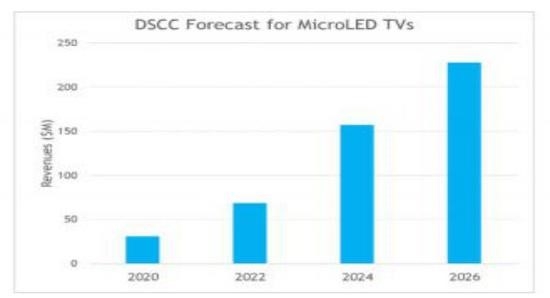Published :11/17/2020 1:57:09 AM
Click Count:2103
Recently, the research institute DSCC analyzed that in the next few years, microLED TVs will usher in rapid growth, and its market size is expected to rise from US$25 million in 2020 to US$228 million in 2026. However, according to DSCC data, the penetration rate of microLED TVs in the TV market is still very small, accounting for only about 0.1% of the market by 2026. For comparison, 6 years after the commercialization of OLED TVs, the market size in 2019 has reached 2.5 billion US dollars.

micrOLED and OLED have great similarities and are superior to OLED at the same time. It has the advantages of self-luminescence, no burn-in, and can drive ultra-high resolution. It is known as the "future display technology." At present, many terminal manufacturers, including Samsung, LG, TCL, Konka, are deploying microLED TV products, and Sharp plans to establish a new company to focus on microLED display technology.
However, the popularity of microLEDs is facing price and cost challenges. According to previous reports, Samsung’s 146-inch first-generation Micro LED "The Wall" is estimated to be about US$100,000, and Konka’s 8K microLED TV is priced at 8.88 million yuan.
DSCC believes that the high price of microLED TVs will be the main factor hindering the rapid growth of its market share. For now, microLED is still in the early stages and is far from reaching the level of mass production.
Third-generation semiconductor materials such as gallium nitride (GaN) help the development of new display technology Micro LED. Micro LED is the next-generation display technology after LCD and OLED, and is currently moving towards commercialization. According to market forecasts, smart phones will become the largest application market for Micro LED, and Micro LED will enter practical applications earlier in the field of wearable devices such as smart watches.
Micro LEDs grow faster on smaller screens, and grow slower on larger screens. In the field of small and medium-sized screens, Micro LED is also promising for vehicle displays because of its transparency, high brightness, and high reliability. Micro LEDs are used for near-eye AR and VR displays and will have applications in industry and medical care. However, due to the high cost, Micro LEDs are expensive to use on TVs and flat panels.
Take the 6-inch Micro LED screen as an example. Starting from 2020, it will gradually increase the functions of low power consumption, high brightness and high refresh rate. It is expected to enter the high-end mobile phone market in 2024 and the popular mobile phone market in 2026, and transparency will be added later. , Flexible function. At present, an LCD mobile phone screen is about US$20 and a MicroLED mobile phone screen is about US$300. As long as the cost of the Micro LED screen is reduced to one-tenth of the current cost, it can enter the high-end mobile phone market.
At present, there are still some technical difficulties and bottlenecks in Micro LED. Chips require high-precision, high-yield manufacturing processes; mass production requires massive transfer technology; chips, backplanes, and drivers need improved processes to achieve high light efficiency; full-color electronic technology and detection technology also need breakthroughs.
Micro LED supply chain is also ushering in opportunities, covering links from substrate, epitaxial growth and wafer, pixel assembly to colorization. At present, in the Micro LED supply chain, chip companies include Epistar, Lunda, San'an, Huacan, Qianzhao, Huayin Core, Osram, Naitron, National Star, etc.; material companies include Merck, etc.; equipment companies have Japan Sub-Chemistry, North Huachuang, China Micro Semiconductor, etc.; IC has Macro, Chichuang North, etc.